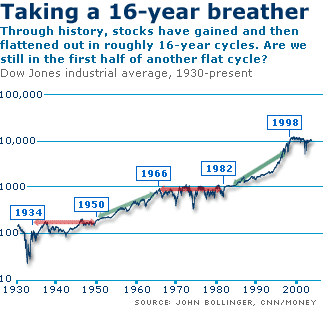
NEW YORK (CNN/Money) -
The 1970s produced many things of debatable merit: disco, feathered hair, the Pinto; some people love them, some people hate them.
But few would disagree that the stock market was lousy in that decade, and some analysts, unfortunately, fear that performance could be repeated in the decade to come.
Between 1970 and 1979, the Dow Jones industrial average gained just 4.8 percent, a pretty miserable performance. Adjust that for the runaway inflation of the period, and things look even worse.
That sluggish decade was in fact part of a longer, 16-year, flat stretch, running from 1966 to 1982, according to many analysts.
Stocks took a similar 16-year breather between 1934 and 1950, according to technical analyst John Bollinger, founder of Bollinger Capital Management, before launching into a 16-year bull market, and the doldrums of 1966-82 set the stage for another bull market from 1982-1998.
If the pattern holds true, then we might not see the next long-lasting bull market until, oh, say, 2014. And Bollinger believes the pattern is holding true.

"We're in a long-term sideways type of market, a consolidation market, typified by alternating cyclical bull and bear markets lasting a year or two each," Bollinger said.
As grim as this may sound, Bollinger believes there are still opportunities for investors who are willing to do some hunting for stocks and sectors that will do well during the short-term ups and downs.
"It's not a free ride -- it requires some work and some skill on the part of investors," he said.
Bollinger is not alone in offering such advice.
"We're no longer in a buy-and-hold environment," said Jack Ablin, chief investment officer at Harris Trust. "You have to be much more active in sector allocation. That's where the future of this business is going."
During these long, flat stretches, there have been some very strong, short-term bull and bear markets. During the 1966-82 doldrums, the S&P 500 enjoyed short bull markets with gains of 48 percent, 72 percent and 125 percent, according to S&P chief investment strategist Sam Stovall.
In other words, a policy of "sell in 1998, go away until 2014," is probably not a great idea.
16 years not set in stone
Bollinger pegs the end of the last 16-year cycle at July 1998, but tech stocks continued to post impressive gains through 2000, and some analysts peg the latest "secular" bull market -- a market in which new all-time highs are set -- as running from 1982-2000.
Very generally, stocks have historically responded to prevailing economic conditions, which have affected corporate earnings, and these have changed together in patterns of similar duration. Sixteen years is just a rough framework.
"A capitalist economy goes through cycles, and 2000 was the peak in the latest cycle, which had lots of similarities to the 1960s and the 1920s," said Ken Tower, chief market strategist at CyberTrader. "Now we're somewhere in this sort of troublesome period like the 1970s."
In the 1970s, the economy suffered from the vicious, inflationary hangover after the boom that followed World War II. There's a chance we could be in for similar headaches in the wake of the late-1990s tech boom, dogged by walloping trade and budget deficits and waiting for the technology that will drive the next gold rush.
On the other hand, the economy has obviously changed a great deal in recent decades, shifting from manufacturing to services, which tend to be less cyclical. And the three-year bear market that began in 2000, along with a recession and sluggish recovery, cleaned up a lot of the late-90s' excesses.
What's more, stock traders have much better access to information and can make corrections much more quickly, according to Stovall of S&P, meaning 16-year cycles could mercifully join rainbow suspenders on the scrap heap.
"History would say that, whenever we have an extended up-move, chances are you need to catch your breath and go sideways for a while," Stovall said. "Is it possible that will happen now? Yes. Is it necessary? No."
Still, if all the problems from the late 90s haven't been cleaned up yet -- and some analysts say debt and price-earning ratios are still too high -- then the market could be in for more consolidation.
"It's hard to argue we're at a major low where everybody hates stocks, where everything is washed out and balance sheets are totally cleaned up -- all those things that occur when we get to a major low," said Sam Burns, research analyst at Ned Davis Research.
"There's still some evidence people can point to that shows we haven't cleaned out all the excesses."

|

